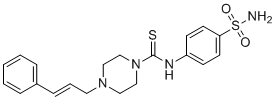LF3
This product is for research use only, not for human use. We do not sell to patients.

For small sizes, please check our retail website as below: www.invivochem.com
| Size | Price | Stock |
|---|---|---|
| 250mg | $750 | Check With Us |
| 500mg | $1150 | Check With Us |
| 1g | $1725 | Check With Us |
Cat #: V2725 CAS #: 664969-54-4 Purity ≥ 98%
Description: LF3 is a specific antagonist of the β-Catenin/TCF4 interaction with antitumor activity; it acts by disrupting the interaction between β-catenin and TCF4 with an IC50 of 1.65 μM.
Top Publications Citing Invivochem Products
Publications Citing InvivoChem Products
Product Promise

- Physicochemical and Storage Information
- Protocol
- Related Biological Data
- Stock Solution Preparation
- Quality Control Documentation
| Molecular Weight (MW) | 416.56 |
|---|---|
| Molecular Formula | C20H24N4O2S2 |
| CAS No. | 664969-54-4 |
| Storage | -20℃ for 3 years in powder formr |
| -80℃ for 2 years in solvent | |
| Solubility In Vitro | DMSO: 83 mg/mL (199.3 mM)r |
| Water: <1 mg/mLr | |
| Ethanol: 5 mg/mL (12.0 mM) | |
| SMILES Code | S=C(N1CCN(C/C=C/C2=CC=CC=C2)CC1)NC3=CC=C(S(=O)(N)=O)C=C3 |
| Synonyms | LF-3; LF 3 |
| Protocol | In Vitro | LF3 inhibits Wnt/β-catenin signals in cells with exogenous reporters and in colon cancer cells with endogenously high Wnt activity. LF3 also suppresses features of cancer cells related to Wnt signaling, including high cell motility, cell-cycle progression, and the overexpression of Wnt target genes. However, LF3 does not cause cell death or interfere with cadherin-mediated cell-cell adhesion. Remarkably, the self-renewal capacity of cancer stem cells is blocked by LF3 in concentration-dependent manners |
|---|---|---|
| In Vivo | LF3 reduces tumor growth and induces differentiation in a mouse xenograft model of colon cancer. Tumor growth is significantly reduced when mice with GFPhigh cells are treated with LF3 at 50 mg/kg. LF3 treatment does not disturb the normal histology of the gut of mice |
These protocols are for reference only. InvivoChem does not
independently validate these methods.
| Solvent volume to be added | Mass (the weight of a compound) | |||
|---|---|---|---|---|
| Mother liquor concentration | 1mg | 5mg | 10mg | 20mg |
| 1mM | 2.4006 mL | 12.0031 mL | 24.0061 mL | 48.0123 mL |
| 5mM | 0.4801 mL | 2.4006 mL | 4.8012 mL | 9.6025 mL |
| 10mM | 0.2401 mL | 1.2003 mL | 2.4006 mL | 4.8012 mL |
| 20mM | 0.1200 mL | 0.6002 mL | 1.2003 mL | 2.4006 mL |
The molarity calculator equation
Mass(g) = Concentration(mol/L) × Volume(L) × Molecular Weight(g/mol)
Mass
=
Concentration
×
Volume
×
Molecular Weight*
The dilution calculator equation
Concentration(start)
×
Volume(start)
=
Concentration(final)
×
Volume(final)
This equation is commonly abbreviated as: C1 V1 = C2 V2
Concentration(start)
C1
×
Volume(start)
V1
=
Concentration(final)
C2
×
Volume(final)
V2
Step One: Enter information below
Dosage mg/kg
Average weight of animals g
Dosing volume per animal µL
Number of animals
Step Two: Enter the in vivo formulation
%DMSO
+
%
+
%Tween 80
+
%ddH2O
Calculation Results:
Working concentration:
mg/ml;
Method for preparing DMSO master liquid:
mg
drug pre-dissolved in
µL
DMSO(Master liquid concentration
mg/mL)
,Please contact us first if the concentration exceeds the DMSO solubility of the batch of drug.
Method for preparing in vivo formulation:
Take
µL
DMSO master liquid, next add
µL
PEG300, mix and clarify, next add
µL
Tween 80,mix and clarify, next add
µL
ddH2O,mix and clarify.
Note:
- (1) Please be sure that the solution is clear before the addition of next solvent. Dissolution methods like vortex, ultrasound or warming and heat may be used to aid dissolving.
- (2) Be sure to add the solvent(s) in order.




































